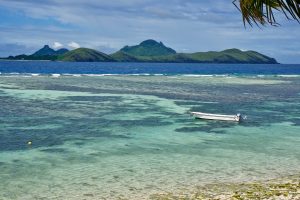As countries around the world look to kickstart their economies, following weeks or months of lockdown, Pacific Island nations emerge divided on how to reopen their borders.
The idea of a travel “bubble” in the Pacific was first aired during discussions between New Zealand and Australia just over a month ago. Since then, there have been calls from senior lawmakers in both countries for the bubble to be extended to their Pacific neighbors. Some Pacific leaders support the proposal, while others have said it’s way too soon.
The Pacific remains mostly virus-free, since they were quick to close their borders to China, and then the rest of the world as the virus spread. Pacific nations have not, however, escaped the economic impacts of the pandemic. The loss of tourism has been especially devastating.
The Cook Islands, for instance, derives nearly 70 percent of its GDP from tourism, while last year, Fiji had more people visit the country than it had residents living there.
A trans-Pacific bubble would enable the freer movement of people and goods to those economies but with underdeveloped healthcare systems the risk of COVID-19 may outweigh the benefits of kickstarting a flailing economy.
Fiji, which has had 18 recorded cases of COVID-19 but no new cases in the past six weeks, was first to raise its hand. The Attorney-General and Economy Minister Aiyaz Sayed-Khaiym told the Australian Financial Review last month that his country was ready to welcome tourists back to the South Pacific.
“A travel bubble that includes Fiji alongside Australia and New Zealand would do far more good than any aid or assistance,” he said. “While we’re incredibly grateful for the help of our larger regional neighbors, Fijians yearn to swim sustainably, not just be kept afloat.”
Cook Islands Tourism chief executive, Halatoa Fua, said: “We believe little pockets like ourselves, currently free of the virus, and exercising caution should be able to reopen.”
Vanuatu remains cautious but has also expressed interest and has confirmed it’s had talks with Australian officials about the idea. In Vanuatu, up to 75 percent of those employed in tourism are now unemployed, all while the country is still rebuilding following the devastation of Cyclone Harold.
While some countries have formally asked to join, Prime Ministers Jacinda Ardern and Scott Morrison have made it clear that re-establishing travel between New Zealand and Australia is their initial priority and until that proves safe a broader bubble will not be considered.
When asked why parts of the Pacific won’t reopen to Kiwi travellers, New Zealand Foreign Affairs Minister Winston Peters said he was also concerned about COVID-19 being exported into the region.
“The last thing we want to do is imperil those populations,” he said.
Peters’ concern about the virus finding its way from New Zealand to some of their Pacific neighbors is not unfounded. In October of last year, a deadly measles epidemic killed 83 people in Samoa after a traveller from Auckland brought it in.
Samoan Prime Minister Tuilaepa Sa’ilele Mailelegaoi said last month that his country can’t trust any flight coming in will be virus free and that with only 240 test kits, they “would not be able to cope with an outbreak.”
“Once bitten twice shy, we have been hit hard by measles and we did not want to be hit hard a second time,” he said.
Tonga’s top health official, Siale ‘Akau’ola, said that they would first let travellers in from countries that are completely free of COVID-19 before considering travellers from Australia and New Zealand.
The Secretary General of the Pacific Islands Forums, Dame Meg Taylor told an Asia Society Policy Institute event that while several Pacific countries had approached New Zealand and Australia about being included in the bubble, the first priority “is that people stay healthy.”
“We just don’t have strong health systems, health services, and health infrastructure,” she said. “If you’re going to open up, you’ve got to have some kind of security there so that anyone coming into your county, and your citizens as well, feel secure enough that they will be taken care of if there is a case that comes into the country.”
New Zealand now claims it has no community transmission, but Australia’s COVID-19 cases are still ticking up, albeit at a manageable rate. Nonetheless, Australian MP Dave Sharma told the Lowy Institute that he’s hopeful of the bubble being extended and that travel may resume to some Pacific Island countries this year.
A poll published last month by the Lowy Institute found the majority of Australians “remain as willing to travel as prior to the outbreak.”
It’s possible that before travel is allowed, Australia, New Zealand, and participating Pacific Island nations will look to resume the labor mobility scheme. This would see thousands of people from almost a dozen countries across the Pacific coming to Australia and New Zealand to help fill labor shortages and in turn, additional opportunities are provided for workers to earn income and develop skills.

































